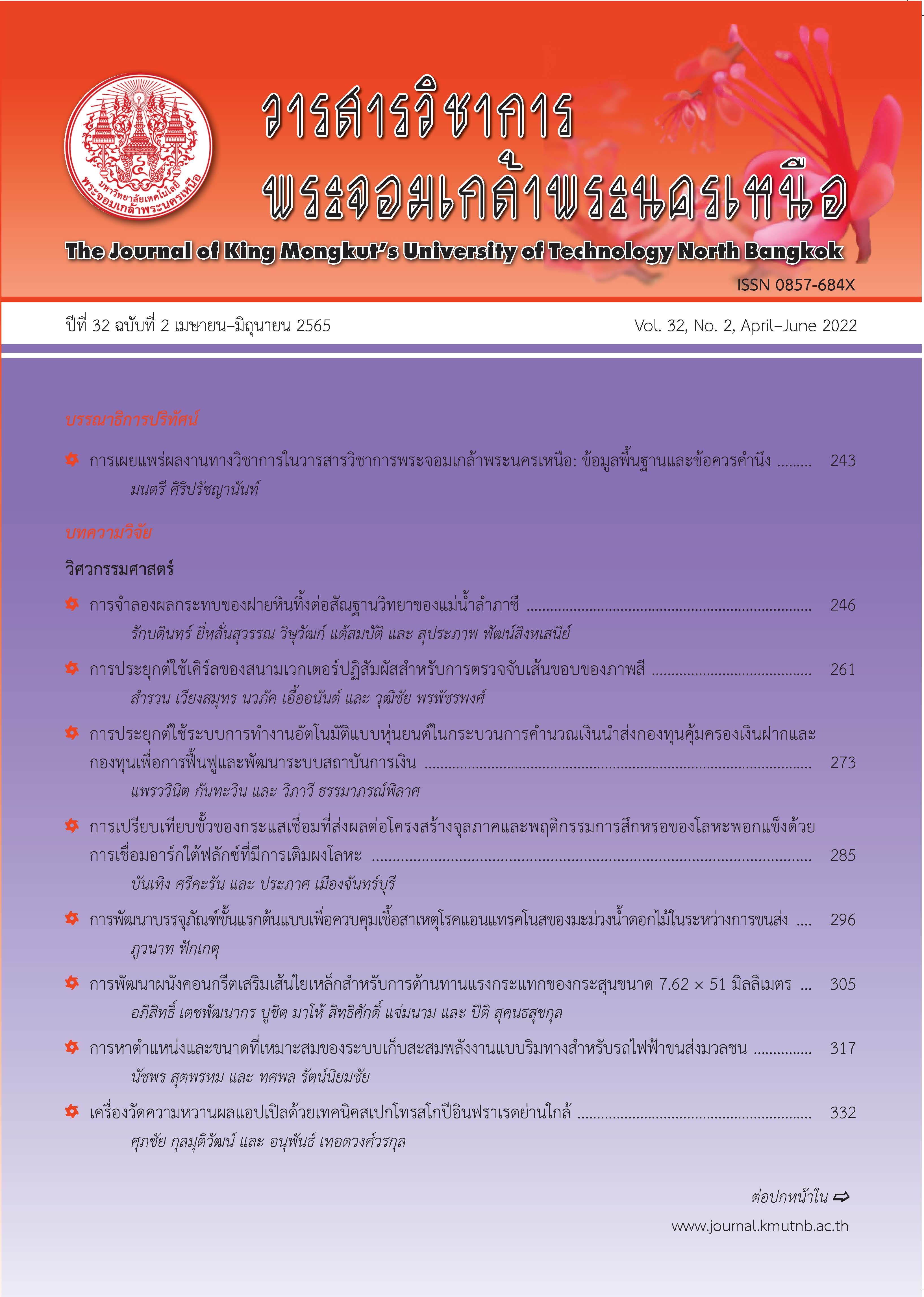การพัฒนาผนังคอนกรีตเสริมเส้นใยเหล็กสำหรับการต้านทานแรงกระแทกของกระสุนขนาด 7.62 x 51 มิลลิเมตร
Main Article Content
บทคัดย่อ
งานวิจัยครั้งนี้ เป็นการพัฒนาผนังคอนกรีตเสริมเส้นใยเหล็ก ให้สามารถต้านทานกระสุนปืนขนาด 7.62 x 51 มม. ได้ ซึ่งผนังทดสอบเป็นคอนกรีต เสริมเส้นใยเหล็กที่สัดส่วน 2% โดยปริมาตรและ แปรผันความหนา ตั้งแต่ 10 - 100 มม. และทดสอบด้วยการยิง 1 นัด บริเวณกึ่งกลางผนัง พร้อมบันทึกภาพ ด้วยกล้องถ่ายภาพความเร็วสูงที่ อัตราเร็ว 40,000 เฟรมต่อวินาที สำหรับการวิเคราะห์ผล ความสามารถในการดูดซับพลังงานจลน์ของผนัง คำนวณจากผลต่างระหว่างพลังงานจลน์ของกระสุน (ก่อนและหลังการปะทะ) โดยความเร็วของกระสุน คำนวณได้จากภาพถ่ายความเร็วสูง จากผลทดสอบ พบว่า การต้านทานกระสุนและความสามารถในการดูดซับพลังงานจลน์สูงขึ้น ตามความหนาของผนังที่สูงขึ้น โดยผนังสามารถต้านทานการทะลุผ่านของกระสุนได้ ที่ความหนา 60 มม. แต่ยังพบการหลุดร่อนของเศษคอนกรีตที่ด้านหลัง และเมื่อผนังมีความหนามากกว่า 80 มม. ขึ้นไป ไม่พบการทะลุผ่านของกระสุนรวมถึงไม่พบรอยแตกร้าวของคอนกรีตที่พื้นผิวด้านหลัง ส่วนความเสียหายของผนัง (เส้นผ่านศูนย์กลางการกะเทาะ, ร้อยละการสูญเสียน้ำหนัก) สามารถแสดงผลเป็นความสัมพันธ์กับความสามารถในการดูดซับพลังงานจลน์ของผนัง
Article Details

อนุญาตภายใต้เงื่อนไข Creative Commons Attribution-NonCommercial-NoDerivatives 4.0 International License.
บทความที่ลงตีพิมพ์เป็นข้อคิดเห็นของผู้เขียนเท่านั้น
ผู้เขียนจะต้องเป็นผู้รับผิดชอบต่อผลทางกฎหมายใดๆ ที่อาจเกิดขึ้นจากบทความนั้น
เอกสารอ้างอิง
S. Jitpiromsri, “Summary of Incidents in Southern Thailand,” Center for Conflict Studies and Cultural Diversity, Prince of Songkla University, Pattani Campus, January 2004 – June 2020 (in Thai).
Institute for Economics & Peace. Global Terrorism Index 2019: Measuring the impact of terrorism, [Online]. Available: http://visionofhumanity. org/reports/
D.-Y. Yoo and N. Banthia, “Impact resistance of fiber-reinforced concrete – A review,” Cement and Concrete Composites, vol. 104, 2019.
S. R. Abid, M. L. Abdul-Hussein, N. S. Ayoob, S. H. Ali, and A. L. Kadhum, “Repeated drop-weight impact tests on self-compacting concrete reinforced with micro-steel fiber,” Heliyon, vol. 6, no. 1, 2020.
P. Sukontasukkul, S. Jamnam, K. Rodsin, and N. Banthia, “Use of rubberized concrete as a cushion layer in bulletproof fiber reinforced concrete panels,” Construction and Building Materials, vol. 41, pp. 801–811, 2013.
S. Jamnam, B. Maho, A. Techaphatthanakon, and P. Sukontasukkul, “Investigation on bullet resistant of steel fiber reinforced concrete panel subjected to .44 Magnum bullet,” Journal of Thailand Concrete Association, vol. 7, no. 1, pp. 39–46, 2019 (in Thai).
S. Jamnam, B. Maho, A. Techaphatthanakon, Y. Sonoda, D. Yoo, and P. Sukontasukkul, “Steel fiber reinforced concrete panels subjected to impact projectiles with different caliber sizes and muzzle energies,” Case Studies in Construction Materials, vol. 13, 2020.
R. Sovják, T. Vavřiník, J. Zatloukal, P. Máca, T. Mičunek, and M. Frydrýn, “Resistance of slim UHPFRC targets to projectile impact using in-service bullets,” International Journal of Impact Engineering, vol. 76, pp. 166–77, 2015.
R. Sovják, D. Shanbhag, P. Konrád, and J. Zatloukal, “Response of thin UHPFRC targets with various fibre volume fractions to deformable projectile impact,” in Proceedings AMCM, 2017, vol. 193, pp. 3–10.
J. Fenga, X. Gao, J. Li, H. Dong, W. Yao, X. Wang, and W. Sun, “Influence of fiber mixture on impact response of ultra-high-performance hybrid fiber reinforced cementitious composite,” Composites Part B: Engineering, vol. 163, pp. 487–496, 2019.

